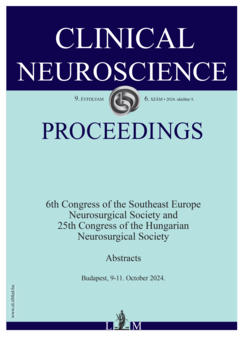Spinal epidural hematoma: Therapeutic challenge
MALEK Bourgou1, MANSOUR Wiem1, BELHAJ Ala1, SLIMANE Abdelhfidh1, KALLEL Jalel1
2024. OKTÓBER 09.
Ideggyógyászati Szemle Proceedings - 2024;9(6)
MALEK Bourgou1, MANSOUR Wiem1, BELHAJ Ala1, SLIMANE Abdelhfidh1, KALLEL Jalel1
2024. OKTÓBER 09.
Ideggyógyászati Szemle Proceedings - 2024;9(6)
Szöveg nagyítása:

Spontaneous spinal epidural hematoma (SHE) is a rare entity. Surgical decompression and evacuation are the gold standard for therapeutic management. However conservative treatment can be proposed in rare cases.
We present the case of a 58-year-old patient with a history of post-hepatitis C hepatocellular insufficiency who presented with right lower limb weakness and dorsal pain. Spinal MRI revealed a right posterolateral epidural hematoma at the cervicodorsal junction. Given the patient’s clinical condition, with a prothrombin time of 58% and platelet count of 58,000 per ml, we opted for conservative management. One month later, the patient presented at follow-up a complete regression of her motor deficit. Compressive SEHs with neurological deficits constitute a neurosurgical emergency, with surgical treatment being the primary treatment. In cases where surgery carries an increased risk of hemorrhage and there is neurological stability or improvement, conservative management should be considered as a wise approach.
Ideggyógyászati Szemle Proceedings
Despite evidence based institutional protocols being in place in many countries, aneurysmal subarachnoid hemorrhage (SAH) continues to be a major socio-economic burden with many open questions remaining regarding the optimal management of the affected patients.
Ideggyógyászati Szemle Proceedings
Additive manufacturing has gained significant traction in industrial applications due to its high potential when it comes to manufacturing objects with complex geometry.
Ideggyógyászati Szemle Proceedings
Not only other surgical and robotic fields, but minimally invasive procedures in spine surgery have undergone significant development in recent times. A demand emerged from both surgeons and patients to develop and perform these types of surgeries in order to prevent biomechanical and surgical complications.
Ideggyógyászati Szemle Proceedings
Arteriovenous malformation (AVM) is an anomaly of blood vessel formation. Numerous models have been established to understand the nature of AVM.
Ideggyógyászati Szemle Proceedings
N,N-Dimethyltryptamine is a natural hallucinogen, the active ingredient of the brew called ayahuasca consumed by Amazonian tribes for spiritual purposes.
Ideggyógyászati Szemle
[A Parkinson-kór (PD) heterogén neurodegeneratív betegség, aminek különböző altípusait ellentmondásos klinikai eredmények jellemzik. A betegség megnyilvánulhat tremordomináns (TD) vagy nem tremordomináns (NTD) fenotípussal. Bár a TD altípus jobb prognózist mutathat, a fenotípusos különbségekről az axiális tünetek mértékét illetően korlátozott információ áll rendelkezésre. ]
Hypertonia és Nephrologia
A 2-es típusú cukorbetegség gyakori szövődményei a krónikus veseelégtelenség és a krónikus szívelégtelenség. A krónikus veseelégtelenség és a krónikus szívelégtelenség azonban egymás kialakulását és romlását is segíthetik, illetve korábban és súlyosabban jelentkezhetnek cukorbetegség esetén. Továbbá, a krónikus vese-, illetve szívelégtelenség esetén a 2-es típusú cukorbetegség is gyakrabban fordulhat elő.
Ideggyógyászati Szemle Proceedings
A Magyar Neuroimmunológiai Társaság X. Kongresszusa Absztraktfüzet Siófok, Magyarország 2023. október 26–28.
Ideggyógyászati Szemle Proceedings
Not only other surgical and robotic fields, but minimally invasive procedures in spine surgery have undergone significant development in recent times. A demand emerged from both surgeons and patients to develop and perform these types of surgeries in order to prevent biomechanical and surgical complications.
Ideggyógyászati Szemle
A krónikus subduralis haematoma az egyik leggyakoribb idegsebészeti-műtéti megoldást igénylő kórkép, ami a legtöbb esetben legyengült idősek betegsége. A standard idegsebészeti nyílt műtétek (trepanáció és craniotomia) mellett alternatív megoldásként az arteria meningea media embolisatiója is szóba jön. Számos összefoglaló tanulmány igazolta az endovascularis kezelés nagyon magas arányú sikerességét és veszélytelenségét
The role of neuroendoscopy in the evacuation of non-liquid chronic subdural hemorrhage
Nyaki porckorong-betegséghez társuló nyaki syringomyelia
1.
2.
3.
4.
5.
Egészségpolitika
Hadiállapotként kezeli és így is reagál a kormány az egészségügy „rendezésére”1.
2.
3.
4.
5.